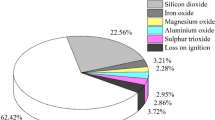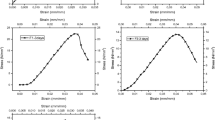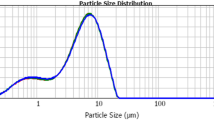Abstract
Today, with the expansion of industries and construction activities, attention to environmental issues such as sustainable development, recycling, reuse, etc. becomes important. The global demand for cement production has been increasing. One ton of cement releases about one ton of carbon dioxide into the atmosphere. Also, after freshwater, sand is considered the second natural resource that is consumed.
Due to the limited sand resources and the concerns around the environmental issues of cement production, in this study, the use of waste foundry sand (WFS) as an alternative to aggregate in slag-based geopolymer mortars as an alternative to cement has been considered. WFS is a by-product of the foundry industry, which is produced in large quantities and buried in landfills, and slag is the by-product of iron and steel making process which is highly cementitious and high in calcium silicate hydrates (CSH).
In this study, the mechanical, durability properties, and environmental assessment of geopolymer mortars using WFS were investigated. The results show that the compressive strength of geopolymer mortars containing treated WFS at the age of 91 days had an increase of 158% compared to cement-based mortars. The adhesion and flexural strength in geopolymer mortars containing treated WFS compared to untreated mortars increased by 145% and 18%, respectively. Toxicity characteristic leaching procedure (TCLP) results showed that the concentration of heavy metals in the leachate WFS, mortars containing treated and untreated WFS, and ground granulated blast-furnace (GGBF) slag was within the standard permitted limitations and WFS is not a hazardous waste.









Similar content being viewed by others
Data Availability
The authors confirm that the data supporting the findings of this study are available from the corresponding author on request.
References
Alapour, F. (2012). Feasibility of producing geopolymer mortars using supplementary cementitious materials. Master Thesis, Amirkabir University of Technology.
ASTM,“C596:Standard test method for drying shrinkage of mortar containing hydraulic cement”,Annual Book of ASTM Standard,American Society for Testing and Materials. (2015). USA.
ASTM C109"Standard test method for compressive strength of hydraulic cement mortars (using 2-in. or [50-mm] cube specimens)". (2008). 1–9.
ASTM C1437"Standard test method for flow of hydraulic cement mortar". (2009). 6–7.
ASTM C157"Standard test method for length change of hardened hydraulic-cement mortar and concrete". (2009). i, 1–7.
ASTM C188"Standard test method for density of hydraulic cement". (2009). 16–17.
ASTM C305"Standard practice for mechanical mixing of hydraulic cement pastes and mortars of plastic consistency". (2009). 6–8.
ASTM C348"Standard test method for flexural strength of hydraulic-cement mortars". (2009). 1–6.
ASTM C490"Standard practice for use of apparatus for the determination of length change of hardened cement paste, mortar, and concrete". (2009). 1–5.
ASTM C642" Standard test method for density, absorption, and voids in hardened concrete". (2009).
Bhardwaj B, Kumar P (2019) Comparative study of geopolymer and alkali activated slag concrete comprising waste foundry sand. Constr Build Mater 209:555–565. https://doi.org/10.1016/j.conbuildmat.2019.03.107
Bilal, H., Yaqub, M., Ur Rehman, S. K., Abid, M., Alyousef, R., Alabduljabbar, H., & Aslam, F. (2019). Performance of foundry sand concrete under ambient and elevated temperatures. Materials, 12(16). https://doi.org/10.3390/ma12162645
BS EN 1881–122 “Method for determination of water absorption.” (2004).
Davidovits J, Quentin S (1991) Geopolymers: inorganic polymeric new materials. J Therm Anal 37(8):1633–1656
Etxeberria M, Pacheco C, Meneses JM, Berridi I (2010) Properties of concrete using metallurgical industrial by-products as aggregates. Constr Build Mater 24(9):1594–1600. https://doi.org/10.1016/j.conbuildmat.2010.02.034
Ganesh Prabhu G, Hyun JH, Kim YY (2014) Effects of foundry sand as a fine aggregate in concrete production. Constr Build Mater 70:514–521. https://doi.org/10.1016/j.conbuildmat.2014.07.070
global casting magazine (pp. 23–26). (2018). Retrieved from %0Awww.globalcastingmagazine.com
Gurumoorthy N, Arunachalam K (2019) Durability studies on concrete containing treated used foundry sand. Constr Build Mater 201:651–661. https://doi.org/10.1016/j.conbuildmat.2019.01.014
Iranian National Standard 17993 “Determination of elemental impurities in carbon nanotube samples using induced coupled plasma mass spectrometry.” (2014).
Jafari Nadoushan, M., Ramezanianpour, A. A., & Akbari, M. (2016). Investigation on mechanical properties and shrinkage of slag and pumice-based geopolymer mortars. 10th National Congress in Civil Engineering.
Jafari Nadoushan, M., Ramezanianpour, A. A., & Akbari, M. (2017). Investigation of mechanical properties and shrinkage of geopolymer mortars with slag and pumice base for use as cover in concrete structures. 10th National Congress of Civil Engineering, Faculty of Civil Engineering, Sharif University of Technology, 1.
Joshi, B., Meena, R., kumar Shresth, A., & Regar, R. (2018). A review paper on green concrete. Journal of Civil Engineering and Environmental Technology, 5(2), 122–125. Retrieved from http://www.krishisanskriti.org/Publication.html
Khan MM, Mahajani SM, Jadhav GN, Vishwakarma R, Malgaonkar V, Mandre S (2021) Mechanical and thermal methods for reclamation of waste foundry sand. J Environ Manage 279(October):111628. https://doi.org/10.1016/j.jenvman.2020.111628
Makul N (2019) Combined use of untreated-waste rice husk ash and foundry sand waste in high-performance self-consolidating concrete. Results in Materials 1(July):100014. https://doi.org/10.1016/j.rinma.2019.100014
Malhotra VM (2002) Introduction: sustainable development and concrete technology. Concr Int 24(7):22
de Matos PR, Marcon MF, Schankoski RA, Prudêncio LR Jr (2019) Novel applications of waste foundry sand in conventional and dry-mix concretes. J Environ Manage 244(March):294–303. https://doi.org/10.1016/j.jenvman.2019.04.048
Method, S. T. (2008). BS EN 1097–5 “Tests for mechanical and physical properties of aggregates determination of the water content by drying in a well ventilated oven.” 1–2.
Miguel RE, Ippolito JA, Leytem AB, Porta AA, Banda Noriega RB, Dungan RS (2012) Analysis of total metals in waste molding and core sands from ferrous and non-ferrous foundries. J Environ Manage 110:77–81. https://doi.org/10.1016/j.jenvman.2012.05.025
Nadoushan MJ, Ramezanianpour AA (2016) The effect of type and concentration of activators on flowability and compressive strength of natural pozzolan and slag-based geopolymers. Constr Buil Mater 111(October 2017):337–347. https://doi.org/10.1016/j.conbuildmat.2016.02.086
Nagajothi, S., & Elavenil, S. (2019). Influence of aluminosilicate for the prediction of mechanical properties of geopolymer concrete – artificial neural network. Silicon, 1–11.
Naik, T. R., Kraus, R. N., Ramme, B. W., & Canpolat, F. (2012). Effects of fly ash and foundry sand on performance of architectural precast concrete. JOURNAL OF MATERIALS IN CIVIL ENGINEERIN, (July), 851–859https://doi.org/10.1061/(ASCE)MT.1943-5533.0000432
Naik, T. R., Singh, S. S., & Ramme, B. W. (2001). Performance and leaching assessment of flowable slurry. JOURNAL OF ENVIRONMENTAL ENGINEERIN, (April), 359–368.
Neeraj M, Aashish S, Aman M (2015) Green concrete: an innovative approach to sustainable development. Int J Adv Eng Sci Res 2(9):1–11
Nikravan, M. (n.d.). Stabilization and solidification of hazardous waste in concrete using nanoparticle technology. Master Thesis, Amirkabir University of Technology.
Patiyal N, Kumar J, Sharma AK (2016) Experimental study on geopolymer concrete with partial replacement of fine aggregate with foundry sand. Int J Recent Res Aspects ISSN 3(2):559–569
Ramezanianpor, A., Bahman Zadeh, F., Zolfagharnasab, A., & Ramezanianpour, A. . (2018). Studying the effect of the amount of source materials and water to binder ratio on chloride ions ingress in alkali-activated slag concretes. Am J Civ Eng 673–684. https://doi.org/10.22060/ceej.2016.695
Sabour, M. R., Akbari, M., & Dezvareh, G. (2019). Utilization of color change and image processing to evaluate the Waste Foundry Sand reclamation level. J Mater Res Technol, (x x), 1–7. https://doi.org/10.1016/j.jmrt.2019.11.041
Şahmaran M, Lachemi M, Erdem TK, Yücel HE (2011) Use of spent foundry sand and fly ash for the development of green self-consolidating concrete. Mater Struct Et Constr 44(7):1193–1204. https://doi.org/10.1617/s11527-010-9692-7
Sandhu RK, Siddique R (2019) Strength properties and microstructural analysis of self-compacting concrete incorporating waste foundry sand. Constr Build Mater 225:371–383. https://doi.org/10.1016/j.conbuildmat.2019.07.216
Sheibani, A., & Tadayon, M. (2009). Effect of cement grade (ratio of aggregate to cement) on water absorption. The First National Concrete Conference of Iran.
Siddique R, Aggarwal Y, Aggarwal P, Kadri EH, Bennacer R (2011) Strength, durability, and micro-structural properties of concrete made with used-foundry sand (UFS). Constr Build Mater 25(4):1916–1925. https://doi.org/10.1016/j.conbuildmat.2010.11.065
Siddiquea R, Kaur G, Rajor A (2010) Waste foundry sand and its leachate characteristics. Resour Conserv Recycl 54(12):1027–1036. https://doi.org/10.1016/j.resconrec.2010.04.006
Singh G, Siddique R (2012a) Abrasion resistance and strength properties of concrete containing waste foundry sand (WFS). Constr Build Mater 28(1):421–426. https://doi.org/10.1016/j.conbuildmat.2011.08.087
Singh G, Siddique R (2012b) Effect of waste foundry sand (WFS) as partial replacement of sand on the strength, ultrasonic pulse velocity and permeability of concrete. Constr Build Mater 26(1):416–422. https://doi.org/10.1016/j.conbuildmat.2011.06.041
Smarzewski, P. (2020). Mechanical properties of ultra-high performance concrete with partial utilization of waste foundry sand. Buildings, 10(1). https://doi.org/10.3390/buildings10010011
Tadayon, M., Khanzadi, M., Maleki, Mohammad Saeed, & Zahabi, S. (2014). Comparison of specific electrical resistance of concrete measured by volumetric method and electrical conductivity ASTM C1760–12. Sixth Annual National Iranian Concrete Conference, 1–11.
Thaarrini J, Ramasamy V (2016) Properties of foundry sand, ground granulated blast furnace slag and bottom ash based geopolymers under ambient conditions. Periodica Polytechnica Civil Engineering 60(2):159–168. https://doi.org/10.3311/PPci.8014
US EPA Method 1311" Toxicity leaching procedure(TCLP)". (n.d.).
Venkatesan M, Zaib Q, Shah IH, Park HS (2019) Optimum utilization of waste foundry sand and fly ash for geopolymer concrete synthesis using D-optimal mixture design of experiments. Resour Conserv Recycl 148(October2018):114–123. https://doi.org/10.1016/j.resconrec.2019.05.008
Author information
Authors and Affiliations
Contributions
MRS: project supervision, resources, methodology, conceptualization; GD: sample making, formal analysis, investigation, resources, data curation, writing—original draft and editing; MA: methodology, validation, project administration, writing—review and editing.
Corresponding author
Ethics declarations
Ethics approval and consent to participate
Not applicable.
Consent for publication
Not applicable.
Consent for publication
Not applicable.
Conflict of interest
We the undersigned declare that this manuscript is original, has not been published before, and is not currently being considered for publication elsewhere.
We wish to confirm that there are no known conflicts of interest associated with this publication, and there has been no significant financial support for this work that could have influenced its outcome.
We confirm that the manuscript has been read and approved by all named authors and that there are no other persons who satisfied the criteria for authorship but are not listed. We further confirm that the order of authors listed in the manuscript has been approved by all of us.
We confirm that we have given due consideration to the protection of intellectual property associated with this work and that there are no impediments to publication, including the timing of publication, with respect to intellectual property. In so doing, we confirm that we have followed the regulations of our institutions concerning intellectual property.
We understand that the Corresponding Author is the sole contact for the Editorial process (including Editorial Manager and direct communications with the office). She is responsible for communicating with the other authors about progress, submissions of revisions, and final approval of proofs. We confirm that we have provided a current, correct email address which is accessible by the Corresponding Author and which has been configured to accept email from the Journal of Environmental Science and Pollution Research.
Additional information
Responsible Editor: Philippe Garrigues
Publisher's Note
Springer Nature remains neutral with regard to jurisdictional claims in published maps and institutional affiliations.
Rights and permissions
About this article
Cite this article
Sabour, M.R., Derhamjani, G. & Akbari, M. Mechanical, durability properties, and environmental assessment of geopolymer mortars containing waste foundry sand. Environ Sci Pollut Res 29, 24322–24333 (2022). https://doi.org/10.1007/s11356-021-17692-z
Received:
Accepted:
Published:
Issue Date:
DOI: https://doi.org/10.1007/s11356-021-17692-z




